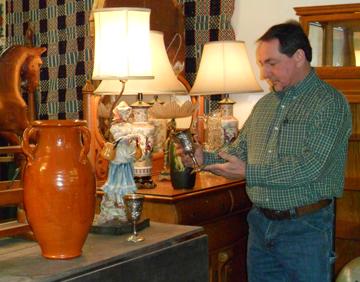IS THIS THE END OF FAMILY HEIRLOOMS?

"Our most treasured family heirlooms are our sweet family memories. The past is never dead, it is not even past."
William Faulkner
A recent article on the NextAvenue.org website (http://www.nextavenue.org/nobody-wants-parents-stuff/) paints a bleak picture for the present and future value of family heirlooms.
"For the first time in history of the world, two generations are downsizing simultaneously," says Mary Kay Buysse, a senior move manager, talking about the boomers' parents (sometimes, the final downsizing) and the boomers themselves. "I have a 90-year-old parent who wants to give me stuff or, if she passes away, my siblings and I will have to clean up the house. And my siblings and I are 60 to 70 and we're downsizing."
This, it seems, is 21st-century life - and death. "I don't think there is a future" for the possessions of our parents' generation, says antique dealer Carol Eppel. "It's a different world."
According to the article, many of the staples of previous generations' households - sets of china, large pieces of solid wood furniture, centuries' old family portraits, etc. - no longer fit the lifestyles of Millennials and Gen-Xers.
"Young couples starting out don't want the same things people used to have," says Susan Devaney, a senior move manager. "They're not picking out formal china patterns anymore. I have three sons. They don't want anything of mine. I totally get it."
Mary Kay Buysse agrees. "This is an Ikea and Target generation. They live minimally, much more so than the boomers. They don't have the emotional connection to things that earlier generations did," she notes. "And they're more mobile. So they don't want a lot of heavy stuff dragging down a move across country for a new opportunity."
This phenomenon hits close to home. Over the New Year's holiday, my wife and her siblings divided and distributed the contents of their mother's large Mississippi home, which had been sold after their mother moved to a nursing home. It was a challenging, emotional time for all.
I'm happy to report that the process went smoothly and nearly everything found a new home, thanks in large measure to the fact that there are six children and 16 grandchildren who treasure their family heritage. The secret is that this family knows the family stories and has associated those stories with the physical objects that faithfully served earlier generations of the family. Mindful of that history, newer generations now cherish those heirlooms and share those narratives with their children.
It didn't happen by chance. Back in the early 1990's my wife's father, Henry Ware Hobbs, Jr., took steps to cement his children's affection for their heirlooms. He photographed every heirloom object he owned and wrote a paragraph about each item, summarizing what he knew of its history: who owned it, how they acquired it, how they used it, how it came into his possession, and any other tidbits of information. He distributed a copy of this amazing handmade catalogue to each of his children as part of the process of dividing up his possessions well in advance of his death. In other words, he related and preserved the story of each painting, chair, table, and armoire, and its role in the family's history.
Upon his untimely passing a few years later, those heirlooms were distributed to his children. As those objects found new homes, they were considered by their new owners as far more than just dishes, artwork, or pieces of furniture. They were tangible symbols of who the family was and is, and visible links between today's generations and their ancestors. They tied Henry's children to their roots and helped them answer the universal question, "Who am I?"
Story is the key. The NextAvenue.org article reinforces this point.
"Every single person, if their parents are still alive, needs to go back and collect the stories of their stuff," says financial adviser Holly Kylen.
One of Kylen's clients inherited a set of beautiful gold-trimmed teacups, saucers and plates. Her mother had told her she'd received them as a gift from the DuPonts because she had nursed for the legendary wealthy family. Turns out, the plates were custom-made for the DuPonts. The client decided to keep them due to the fantastic story.
Henry Hobbs' genius lay in understanding that children and grandchildren don't value family heirlooms unless they know both the history of the object and the history of the previous owners. Recognizing this, he then took tangible steps to convey that history to his posterity. His homemade catalogue and its collection of pictures and stories is a treasure in its own right, but it is much, much more. Like the Rosetta Stone of ancient Egypt, it was the key to unlocking the wonders of the past for current and future generations of the Hobbs family.

Physical objects with no story attached are just stuff. But they become real treasures when connected to their narrative. Stories bring those objects to life and help us understand their role in the fabric of the family. Loved ones' legacies are perpetuated when personal possessions and family stories are woven together, shared, and passed forward, generation after generation.
So, what can you do to capture, preserve, and pass on your family's artifacts and their stories?
No comments:
Post a Comment